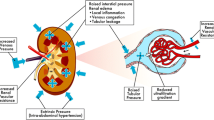Abstract
The antifibrotic effect of heparin, an anticoagulant used routinely in the treatment of peritonitis, is unknown, whereas antithrombin III (AT-III) has both anticoagulant and anti-inflammatory actions. The aim of this study was to compare the antifibrotic and anti-inflammatory effects of AT-III and heparin in rats with experimentally developed peritonitis while on peritoneal dialysis (PD). Sixty-four Wistar albino rats (in four groups of 16) were used in the study. Group 1 received PD solution only, group 2 had experimentally developed peritonitis in addition to PD solution; group 3 received heparin intraperitoneally for 3 days, in addition to group 2; and group 4 received AT-III intraperitoneally for 3 days, in addition to group 2. Plasma and dialysate levels of tissue-plasminogen activator were similar in heparin and AT-III groups on both day 3 and day 14. The inflammation scores of heparin and AT-III groups were also similar in both early and late phases. The fibrosis score of the AT-III group was low compared with both peritonitis and heparin groups in the early phase (p = 0.03), though it was similar in the late phase. The effects of AT-III are comparable with that of heparin in PD peritonitis in rats with experimentally developed peritonitis while on PD.


Similar content being viewed by others
References
Warady BA, Morgenstern BZ, Alexander SR (2004) Peritoneal Dialysis. In: Avner ED, Harmon WE, Niaudet P (eds) Pediatric Nephrology, 5th edn. Lippincott Williams & Wilkins, Philadelphia, pp 1375–1394
Sitter T, Spannagl M, Schiffl H, Held E, van Hinsbergh VW, Kooistra T (1995) Imbalance between intraperitoneal coagulation and fibrinolysis during peritonitis of CAPD patients: the role of mesothelial cells. Nephrol Dial Transplant 10:677–683
Nadig C, Binswanger U, von Felten A (1997) Is heparin therapy necessary in CAPD peritonitis? Perit Dial Int 17:493–496
de Boer AW, Levi M, Reddingius RE, Willems JL, van den Bosch S, Schöreder CH, Monnens LA (1999) Intraperitoneal hypercoagulation and hypofibrinolysis is present in childhood peritonitis. Pediatr Nephrol 13:284–287
Tabata T, Shimada H, Emoto M, Morita A, Furumitsu Y, Fujita J, Inoue T, Miki T, Nishizawa Y, Morii H (1990) Inhibitory effect of heparin and/or antithrombin III on intraperitoneal fibrin formation in continuous ambulatory peritoneal dialysis. Nephron 56:391–395
Okajima K, Uchiba M (1998) The anti-inflammatory properties of antithrombin III: new therapeutic implications. Semin Thromb Hemost 24:27–32
Lai KN, Yin JA, Yuen PM, Li PK (1990) Protein C, protein S, and antithrombin III levels in patients on continuous ambulatory peritoneal dialysis and hemodialysis. Nephron 56:271–276
Mori R, Triolo L, De Stefano V, Giusti BP, De Sole P, Leone G (1988) Plasma levels and loss of antithrombin III in chronic ambulatory peritoneal dialysis and nephrotic patients. Nephron 48:213–216
Calame W, Afram C, Blijleven N, Hendrickx RJ, Namavar F, Beelen RH (1993) Establishing an experimental infection model for peritoneal dialysis: effect of inoculum and volume. Perit Dial Int 13:S79–S80
Sjøland JA, Pedersen RS, Jespersen J, Gram J (2005) Intraperitoneal heparin ameliorates the systemic inflammatory response in PD patients. Nephron Clin Pract 100:c105–c110
Bazargani F, Albrektsson A, Yahyapour N, Braide M (2005) Low molecular weight heparin improves peritoneal ultrafiltration and blocks complement and coagulation. Perit Dial Int 25:394–404
Pawlaczyk K, Kuzlan-Pawlaczyk M, Anderstam B, Heimbürger O, Bergström J, Waniewski J, Breborowicz A, Lindholm B (2001) Effects of intraperitoneal heparin on peritoneal transport in a chronic animal model of peritoneal dialysis. Nephrol Dial Transplant 16:669–671
Sjøland JA, Smith Pedersen R, Jespersen J, Gram J (2004) Intraperitoneal heparin reduces peritoneal permeability and increases ultrafiltration in peritoneal dialysis patients. Nephrol Dial Transplant 19:1264–1268
Bazzato G, Fracasso A, Gambaro G, Baggio B (1995) Use of glycosaminoglycans to increase efficiency of long-term continuous peritoneal dialysis. Lancet 346:740–741
De Vriese AS, Mortier S, Cornelissen M, Palmans E, Vanacker NJ, Leyssens A, Faict D, De Ridder L, Lameire NH (2002) The effects of heparin administration in an animal model of chronic peritoneal dialysate exposure. Perit Dial Int 22:566–572
Stiekema JC (1986) Heparin and its biocompatibility. Clin Nephrol 26:S3–S8
Furman KI, Gomperts ED, Hockley J (1978) Activity of intraperitoneal heparin during peritoneal dialysis. Clin Nephrol 9:15–18
Acknowledgements
The study was supported by a grant from The Scientific Research Fund of Akdeniz University.
Author information
Authors and Affiliations
Corresponding author
Rights and permissions
About this article
Cite this article
Akman, S., Koyun, M., Gelen, T. et al. Comparison of intraperitoneal antithrombin III and heparin in experimental peritonitis. Pediatr Nephrol 23, 1327–1330 (2008). https://doi.org/10.1007/s00467-008-0829-7
Received:
Revised:
Accepted:
Published:
Issue Date:
DOI: https://doi.org/10.1007/s00467-008-0829-7




